STRANGER AT A STRANGE CON | |||
|
When it comes to being active in comics fandom, to the extent that I was, the 1980s were
my decade. I moved from my native Wales to London in mid-1980, soon joining its thriving
science fiction fan/pro community. And it really *was* a community then without the divide
that came later. We all socialised together, and it was not unusual to rub shoulders with
such as Robert Holdstock, Geoff Ryman, John Clute, and Christopher Priest at various
gatherings, or to party at their homes. Later in the decade Colin Greenland and Neil
Gaiman joined the mix, as did Avedon Carol who came over from the US to marry me in 1985.
Oh, and John Sladek (who really should have written for Doctor Who given what his surname
is an anagram of).

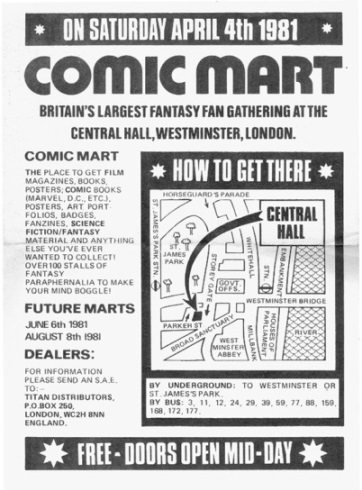
For those of us SF fans also interested in comics - there was always an overlap - one of the regular events on our social calendars was the Comic Mart. This was held bi-monthly in the very grand Westminster Central Hall building and only now does it occur to me just how weird that was. Can you imagine a similar event being held across the road from the White House? On the other hand, the idea of hordes of scruffy fans rummaging through long boxes of old comics within sight of the seat of power that is the Houses of Parliament appeals to my sense of egalitarianism. The Westminster Comic Marts were much more of a social event than the modern London Comic Marts and people would gather in the bar of the nearby Westminster Arms for drink and conversation, making forays into Central Hall as the mood took them. As in science fiction circles, the comics pros of the period socialised with the active fans and this was one of the events where they met up. Alan Moore was a Westminster Arms regular, and he and Avedon would often have long conversations together, probably about politics knowing my wife. After the mart, those of us in the SF fandom contingent would usually head off first for pizza and then for more drinks at The Royal George, a pub near Tottenham Court Road tube station. I remember Neil Gaiman coming along on one occasion and us having to make a side trip to Forbidden Planet. This was in order for him to sell them review copies of a bunch of books so he could afford to eat and drink with us. My, how times have changed! Around 1983 I started getting UK comics fanzines, trading mine for them, and appearing in their letter columns. In 1985 I even drew a cover for an issue of FANTASY ADVERTISER. I'd done dozens of covers for SF fanzines over the years but this was my first (and as it turned out *only*) one for a comics zine. When we caught wind that the UK COMIC ART CONVENTION (UKCAC) was being held in London in 1986, and who would be there, Avedon and I decided to join up for it. We each had more than a decade of attending SF cons behind us and this seemed like a good opportunity to see what comics conventions were like.
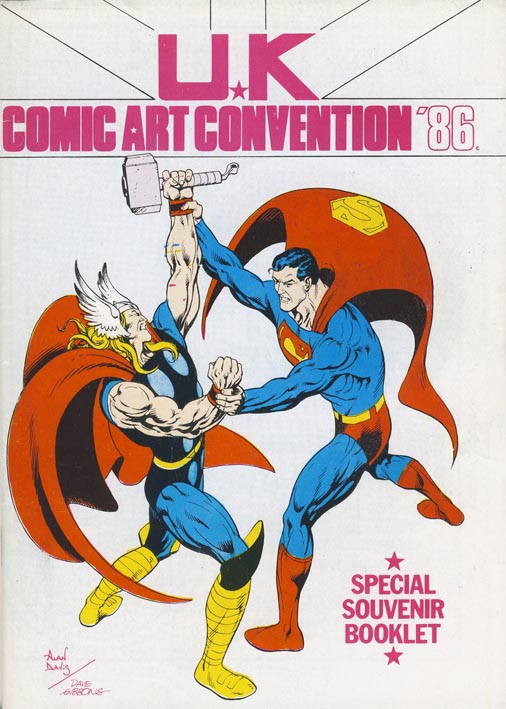
As it happens 1986 was my peak year for attending conventions, and I managed two in February alone. The first of these was MEXICON II which was held in Birmingham, and it was here I got to interview Alan Moore on stage. I was chosen for this task because I was the one most familiar with his work. I hope it went well, but I recall very little of the interview and there are no transcripts. I'm not a natural performer on stage, and was nervous enough that I'm afraid I've blocked out most of my memory of the event. After MEXICON II, Avedon and I flew to the US to attend another convention the following weekend. This was CORFLU 3 (named after the fannish abbreviation for stencil correcting fluid), held that year in Tysons Corner, Virginia. Before flying back to the UK, we spent some time visiting friends in New York, a group of whom then lived in a cluster of apartments in a building on Broadway Terrace in the Washington Heights district, which is located at the northern end of Manhattan. We were on the subway, heading north, when a voice said:
"Avedon!" This was Susie Griffin, an old friend of Avedon's. It's chance encounters like this that make you wonder if the world is actually smaller than it seems.
"Are you on your way to Chris's party?" she asked, after they had exchanged hugs. We weren't and, though tempted, we didn't take her up on her suggestion that we join her. When we reached Broadway Terrace, we learned that one of its number - D. Potter - also knew Claremont. Maybe it really *is* a small world after all. Sadly, D is no longer with us. I learned of her death while writing this very piece. A few years after this, CORFLU 7 was held in New York and one of those I got to meet there was Julius Schwartz. He dropped in one afternoon to talk with us about his days as an SF fan back in the 1930s. CORFLUs typically run to fewer than a hundred people, a size I've learned over the years is the one I'm most comfortable with. The thought of three or four days at a convention as gargantuan as San Diego Comic Con now is fills me with horror, frankly, though the idea of spending a couple of hours wandering around it gawping at all the stuff on display has a certain appeal.
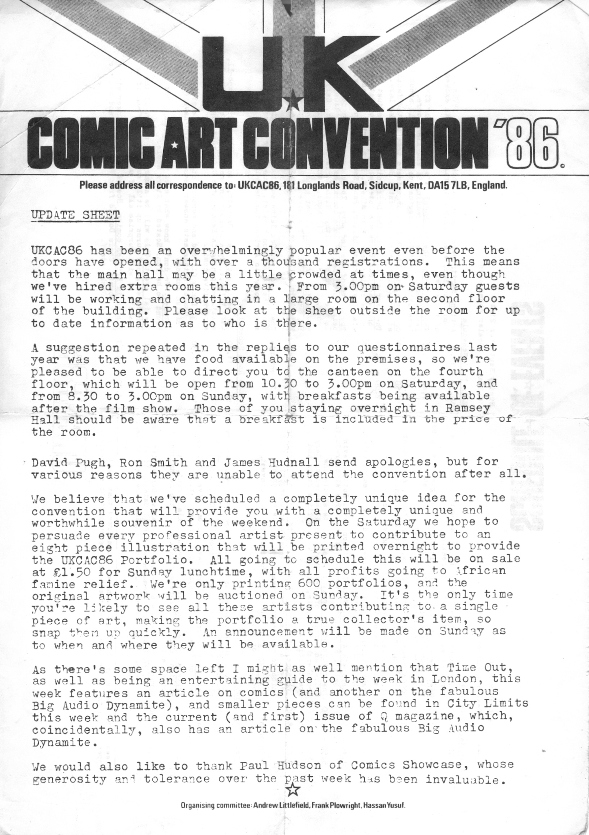
UKCAC86 was held over the weekend of 20th/21st September 1986, and the organisers got lucky with the weather. It was gorgeous, the unseasonable warmth and sunshine making the rooftop patio of the campus building where the con was held a very inviting place to slip out to when eating a snack or taking a drink. The con took place in the University of London Union on Malet Street, close to Goodge Street Underground station, up behind the British Museum. Avedon and I arrived on the first day just in time to miss the 'Meet the Pros' panel. We thought this would put us at a disadvantage when it came to identifying them in the halls but it turned out to be not too big a problem since they weren't greatly present in those halls. Unlike pros at the SF conventions we were familiar with, most of them preferred to rush back to their hotels when their panels were done.
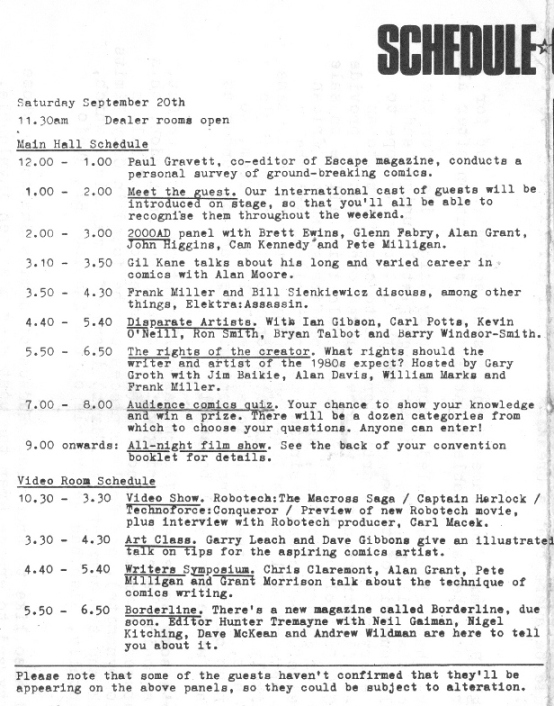
The first one we took in featured legendary comics artist Gil Kane, who had drawn the first American comic my parents ever bought for me (GREEN LANTERN #10 - January 1962), being interviewed by Alan Moore (aided and abetted by Gary Groth), followed by a Miller/Sienkiewicz panel on their ELEKTRA mini-series. These were both pretty interesting, and took us up to the late afternoon break. After buying comics in the dealer's room, Avedon and I feasted on beans and baked potatoes out on the patio. At least that's what it says in my diary. At first I was puzzled by this since I distinctly remembered eating in the Green Room. I'd been astonished to meet two of our SF fandom mates at the convention - Malcolm Edwards, whose fanzines I used to run off on the Gestetner duplicator in my kitchen and who would later become a big cheese at Victor Gollancz, and Leroy Kettle, who would later form one half of horror author Harry Adam Knight, John Brosnan being the other half - and they had taken us to the Green Room. Or so I believed. Avedon remembered none of this. Yet it had to have happened here since UKCAC86 was the only comics convention I ever attended. Except that it wasn't. While writing this piece I turned up my badge and programme book from 1980's 'Marvel Comics Film & Fantasy Convention'.
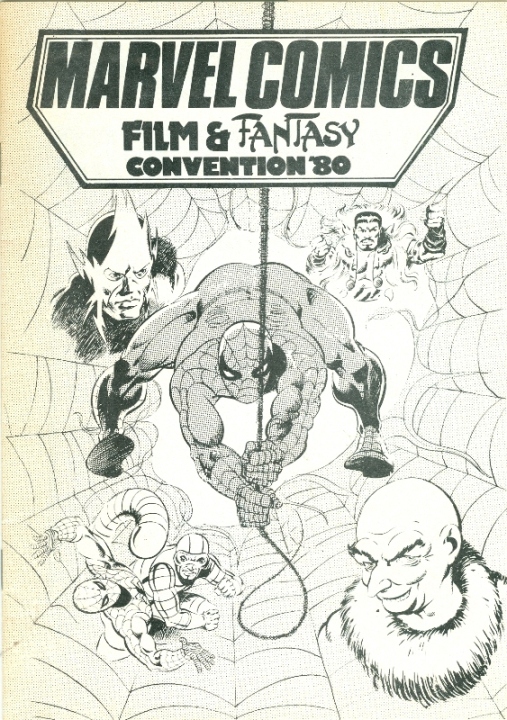
I'd totally forgotten this ever happened and in my memory I'd conflated the two events, convinced I'd only attended the one comics convention. I didn't start keeping a diary until 1982, so I had no record of it. As to why Malcolm and Leroy were at that earlier event, Malcolm recalled:
"My memories are pretty vague, because of the inordinate amount I had to drink that afternoon. I think I was there as Brosnan's guest, but it could have been Dez Skinn or Allan Mackenzie (sp?) or someone else entirely. I dimly remember that there was an actress in the green room who Bros fancied -- Caroline Munro, perhaps?" Dana Gillespie, Malcolm later clarified, though Munro was also present. I attended a panel she was on and at one point, for some reason, she brought up porn star Chesty Morgan:
"...a woman with a seventy-one inch bust." The only reason I knew Morgan's dimensions is because I'd read about a film of hers titled 'Double Agent 73'. That's my story, anyway. Getting back to UKCAC86, the first two panels were eclipsed for us by the 'Creators' Rights' one, hosted by COMICS JOURNAL editor Gary Groth and featuring, among others, X-Men writer Chris Claremont and Marvel Editor in Chief Tom DeFalco. Naturally this focussed mainly on Jack Kirby who was then in dispute with Marvel over the return of his artwork, and it was lively and loud. The audience's sympathies quite clearly and properly lay with Kirby, and I felt a bit sorry for DeFalco and Claremont. They were trying to defend Marvel's indefensible position and must have felt besieged. Claremont even launched into a bozoid defence of capitalism by way of justifying that position at one point, something I suspect he'd have avoided in less pressured circumstances. After the panel Avedon cornered Groth outside the hall to tell him about Ted White's recent arrest, conviction and incarceration for selling marijuana and to pass on Ted's mailing address. (Ted was a friend of Avedon's from their days together in DC area fandom, I was his co-editor on a fanzine now terminated by his imprisonment, and Groth had published him recently in THE COMICS JOURNAL.) While we were talking, DeFalco and Claremont joined us and we found ourselves arguing about Kirby with them. Avedon being Avedon there was some volume involved in this exchange. It turned out that the Marvel men were heading over to the Forbidden Planet party in Oxford Circus, so we offered to show them the way since we were heading home anyway. Chatting to Chris Claremont as we set off, I mentioned our encounter on the New York subway in February with Avedon's friend Susie Griffin.
"She asked us if we were going to the party at your place," I said, "and when we said we weren't suggested we should tag along with her anyway. We were tempted." He also mentioned that while he was in the UK he was hoping to pick up one of the two pound coins that had been issued in limited numbers. As distinct from the coins with the silvery disc in the middle released later, these were essentially a larger version of the original one pound coin. As it happened I had one of these in my pocket so I swapped it for two ones from him, since I could always pick up another later. That was the last time I ever saw one. When we arrived at the pub FP had taken over in its entirety for the night, Avedon and I ended up sailing into it on the shirttails of our companions. I was a little worried at such 'crashing', half-fearing that FP heavies were going to come in and drag us off at any moment, but my fears were unnecessary. The usual crowd were present and both Rob Holdstock and Dave Langford said that they would've had us come as their guests had they known we didn't have invites. The party was an impressive bash, hugely overcrowded but with free booze in all bars and free food (chilli, curry, salad) - sort of like an upmarket version of a regular SF pub meeting. Famous authors like Brian Aldiss and J.G.Ballard were present as were a large number of very glamorous young women, done up to the nines and totally unlike any I'd ever seen at another SF/comics gathering. For a moment or two I found myself wondering whether the hospitality FP laid on for the Really Big Names ran to more than just booze and food. As impressive as all this was, having Adam West show up at the opening party for the Forbidden Planet store on New Oxford Street impressed me more.
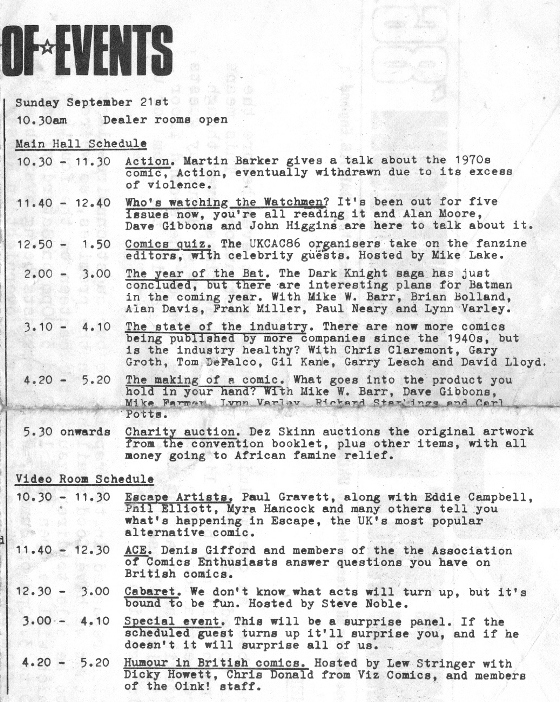
One advantage of a con held in the centre of London was that Avedon and I got to sleep in our own bed, but it made getting to pre-noon panels a little arduous. Even so we were up bright and early the following day to catch the 11.40am panel we wanted to see. Titled 'Who's Watching The Watchmen?' this featured Alan Moore and Dave Gibbons and was moderated by Neil Gaiman, "in a suit, as befitted the occasion". Like everyone who reads comics, Avedon and I were pretty impressed with WATCHMEN, which at this point was being published in its original 12-issue comicbook form. Since Moore usually gave advance photocopies of each issue to Neil, and Neil would often bring these along to social gatherings with him, I'd get several chances at an advance peek during its run but I always resisted the temptation. I didn't consider the pages finished until John Higgins added his colours so I preferred to wait for the completed comic. I was more of a purist in those days than I am now. The panel was informative and the most entertaining of the convention, both because Moore is an interesting guy and because he knows how to ham it up effectively on stage. One anecdote of his I remember concerned the difficulty he'd had with a forthcoming issue of WATCHMEN.
"I just couldn't make the main story and the pirate stuff come together and I was getting a bit depressed about it all, then it hit me: Rorschach/raw shark" He held his hands up to the heavens, shaking them theatrically.
"Thank you, thank you!!" he cried. After the panel Moore was mobbed by admirers seeking his autograph. He was definitely the star of the show or, perhaps more accurately, the *superstar*. I think maybe this was the occasion on which he realised just how big a deal he had become. He was polite with everyone, signing autographs left and right, but he also looked uncomfortable with that level of attention. Fame is a funny thing, and I have to say it's never been something that held any appeal for me. Not that I've ever done anything remotely likely to bring some my way. No, fame as a consequence of being good at something I understand, but going on reality TV shows and the like seeking fame for its own sake is incomprehensible to me. There's a reason I used to say I wanted to be rich and anonymous, and I felt some sympathy for Alan at that moment. Between panels, Avedon got chatting to a woman from Mississippi and her husband, and I joined in. He was a Lancastrian who owned a comics store in the US, and there was much comparing of notes and discussion between us of how higher average pay in the US doesn't necessarily mean you're better off. I was pleased by this. With Avedon having moved to London from the US to marry me the previous year I didn't like to think doing so had meant a significant drop in her living standards. The following panel on Batman - 'The Year of the Bat' - was rendered tedious by artists Alan Davis and Paul Neary's disinclination to give real answers and by moderator Hasan Yusef's inability to ask more than the broadest of questions. So broad, in fact, that some were delivered as statements causing puzzled panellists to ask "Was that a question?" Colourist Lynn Varley (a small, blonde-haired woman) didn't say much, while Frank Miller (tall, long-haired, and declared 'cute' by Avedon) said a lot, much of it disturbing. Revealing that the version of Batman he drew most inspiration from was that of Bill Finger and Jerry Robinson back in the Forties, he described a story in which the dynamic duo were in a race against time to find evidence that would save a man from the electric chair - only during the course of their investigations they discovered that he actually *was* guilty.
"In the last panel of the story", said Miller, "Batman looks at a clock and says, 'Guess they're frying him about now', and I thought hey, this is my kinda guy!" The final panel we took in was titled "The State of the Industry" and it promised to be Sunday's equivalent of yesterday's creators' rights panel. This had Groth and Kane on one side, Claremont and De Falco on the other, and was moderated by someone whose name I didn't catch. It was certainly lively, perhaps a little *too* lively. At one point this exchange took place between Gil Kane and Chris Claremont:
"My boy, let me explain something," said Kane. There seemed to be some deeper animosity between the pair than could be accounted for by the panel alone. I wondered if they'd fallen out over a comic, but couldn't recall them ever working together on one.
"I remember being so horrified by that fight between Kane and Claremont," recalls Avedon, "that I frantically raised my hand and Groth gratefully called on me so I could ask an inconsequential question following up the discussion of the direction of independent comics. And when we talked to him later, it was so weird to have him all to ourselves because no one else was sitting at any of the tables by the bar, or even in the room." It was then that I got to ask Groth the question I couldn't put to him during the Q&A session that followed the Batman panel due to the forest of hands that shot up from those wanting to know how fast the Batmobile could go and what Bruce Wayne's inside leg-measurement is (I exaggerate, of course - but only just), namely:
"To what extent do the politics displayed in THE DARK KNIGHT RETURNS mirror Miller's own?" This might be an heretical opinion, but in the years since this conversation took place I've come to regard THE DARK KNIGHT RETURNS as having ruined Batman. Not because of what Groth and I discussed but because what was supposed to be no more than a story showing one possible future for Batman has instead become a blueprint for the character. There's a direct line between TDKR and the scene in the Batman v Superman movie where Batman is shown mowing down criminals with the twin machine guns mounted on his batmobile. I much prefer the Batman we had immediately prior to THE DARK KNIGHT RETURNS. The comics written then by such as Alan Grant and Mike W. Barr featuring the master detective we rarely see anymore are much more to my taste. Looking back on the con as a whole I'd have to say that the main ways in which it seemed to me it differed from SF conventions lay in the more visible friction between the pros and in a far greater degree of hero-worship by the fans. UKCAC had been an interesting experience, enjoyable even, but we never attended another.

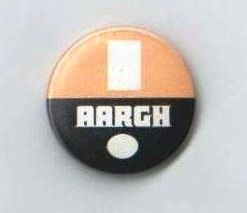
I saw Alan Moore a few more times at various events that year, but he would soon begin to slowly retreat from public appearances and, really, who can blame him? When you're getting mobbed and can no longer even take a pee in peace without people at adjacent urinals grilling you about the comics you've written - as I believe happened to him at UKCAC - why would you want to continue exposing yourself to that? In 1988 Avedon and I marched in the London anti-Clause 28 protest under the AARGH! banner (Artists Against Rampant Government Homophobia) held aloft by Debbie Delano and Moore's then wife, though Alan wasn't there. I don't think I ever saw him in the flesh again. As for Neil Gaiman, he moved to the US in the early-nineties, of course, and we lost touch. Before then I used to regularly bump into him on Thursday evenings after work when I travelled into town to pick up that week's comics from Paul Hudson's COMIC SHOWCASE, then located at the top of Neal Street. On one such occasion Neil told me that Jim Lee had expressed an interest in drawing a SANDMAN story and asked if I was familiar with Lee's work. I took a copy of the then-current X-MEN #268 with its Captain America, Wolverine, and Black Widow cover down from the shelves and handed it to him.
"Oh, that's a shame," he said, leafing through it. I don't think I've ever told this story before, and certainly never in print, so there it is: a new (if minor) piece of data for any SANDMAN scholars out there. [In 2020, Jim did a sketch of the Endless for charity]:
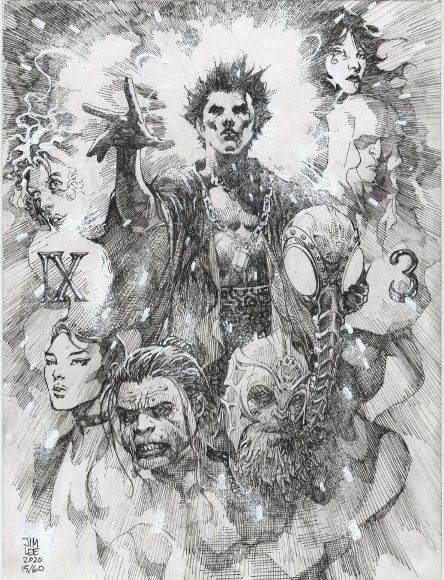
In the months after UKCAC I began researching and writing my history of the first fifty years of science fiction fandom in the UK, and my contacts with comics fandom fell away as the fanzines I'd been getting gradually ceased publication. Over the following years that UK SF fan history, my magnum opus if anything is, was published first in serial form in fanzines, then on the web, and finally - in 2016 - as a much revised 450 page book. I don't know if the same is true for comics, but it's not possible to fully understand the history of genre science fiction in this country during its first few decades without also engaging with fandom, so intertwined were the two. The history of fandom is, if you like, the 'underhistory' of science fiction. (Fun Fact: The Royal National Hotel, venue for the London Comic Mart for many years, is built on the site of the Royal Hotel, which hosted SF conventions in 1951, 1952, and 1970. The 1951 event, dubbed FESTIVENTION because it was held in the same year as the Festival of Britain, was advertised as an 'international convention' and was in all but name the first Eurocon. Indeed, one of the early names considered for it was EUCON.) I haven't drawn anything in ages, and it's been more than two decades since I last put out a fanzine. As the years rolled by my trusty Gestetener sat behind me in my office, a reproachful presence, until 2014 when the call went out for one. The Worldcon had come to London and they needed a duplicator for an item on the fan programme where younger fans could marvel at the primitive technology we employed to produce fanzines back when dinosaurs roamed the Earth. I told them they could have mine, but that I didn't want it back. It was duly carted away and I then blew the dust off my old portable typewriter - bought brand new four decades earlier - and rolled a stencil into it for the first time in almost a quarter of a century. They needed someone to demonstrate how to use the duplicator at the convention, and that someone was of course me. True to their word they didn't try to return it to me after Worldcon was over, but I still had lots of supplies for it - tubes of ink, stencils, many reams of paper (both A4 and quarto) - that I later donated to a group interested in the artistic possibilities of that obsolete technolgy and who came and took all this off my hands. Though it's not always apparent at the time, involvement in fandom can give you skills that are useful in the wider world. My friend Linda parlayed her experience negotiating with hotels as part of various convention committees into a career as an events organiser, while Malcolm Edwards called upon the skills he'd learned in a more political context. I was exchanging emails with him about 1980s activism recently, when he wrote: "I was a committee member of the publishers' CND group BAND (Book Action for Nuclear Disarmament) and when we decided to produce a newsletter it quickly became clear that among these eminent folk (one or two legendary editors, and the man who at the time was the editor of the trade magazine, THE BOOKSELLER) I was the only one who had a clue how to set about producing and printing an eight-page A5 newsletter, which as you know is child's play to anyone who has produced a fanzine or a convention progress report." When he took me up on my offer to draw a cover for FANTASY ADVERTISER, editor Martin Skidmore said he also needed me to do the colour separations. I duly read up on these, produced the different sheets required using multiple grades of Letratone (US: zipatone), and - somewhat to my surprise - the colours turned out OK. Thus did *I* learn a new skill - one I never used again and which is now obsolete, of course. So it goes.

I've been active in various iterations of fandom, to different degrees at different times, for more than forty years and I owe it more than I can say. Fandom has given me lifelong friendships, and a wife. It's taken me to the US many times, and even paid for three of those trips. Without it I wouldn't be where I am now, or even perhaps who I am now. Funny how, without you realising it's happening, a hobby can become a life. - Rob Hansen, November 2017.
|
|||
|
|